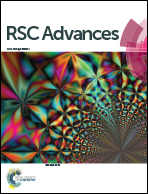Improved microwave synthesis of unsymmetrical N,N'-diaryl-1,2-aminoethane and imidazolidinium salts as precursors of N-heterocyclic carbenes†
Abstract
Lithium aluminium hydride reduction of bis-unsymmetric-diaryloxamides 3 is difficult to accomplish especially for the sterically hindered mesityl derivative. Using microwaves LAH reduction of 3a,d was successful in a short time, however, with cleavage of the ether linkage to give compounds 11a,d. Extension of this method enabled the reduction of bis-oxamide derivatives 13 to the corresponding tetraamine derivative 14 which was then converted to the bis-imidazolidinium salt 15. Application of this method led to rapid reduction of unsymmetric N,N'-diaryloxamides 16 to the corresponding N,N'-diarylethylenediamines 17 which were converted to their corresponding imidazolidinium salts 18.


 Please wait while we load your content...
Please wait while we load your content...